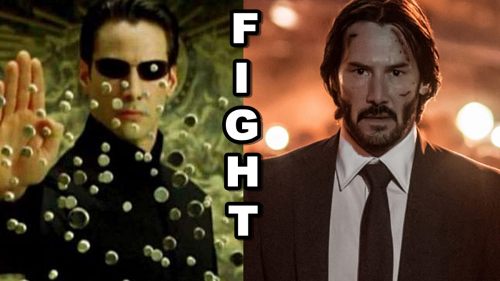Movie Review: SIDE BY SIDE Is An Interesting Lie
For a medium and an industry ostensibly based on voyeurism, cinema has more than its fair share of navel-gazing. With ever more frequency there are documentaries made about movie making, and this newest one, Side by Side, focuses on the current, total transformation from analogue to digital.
It's a topic I'm more interested in than most, considering that I've devoted so much of my professional and personal life to movies. What I discovered after watching Side by Side is that it's something I'd be happy to get into a jovial shouting match about over pints, but isn't quite that interesting to stew on for the length of a feature film. By the film's close I was hoping the film's lead inquisitor (yes, Keanu Reeves, who is warm and with-it) would ask his parade of talking head luminaries to comment on just about any other topic imaginable. I mean, I care about this topic, I do. But also . . .so they shoot movies digitally now. Who cares?
Annoyingly, Side by Side is, on the face of it, a lie. No doubt you are thinking, "Great, here will be an opportunity for me to look at a direct comparison between a celluloid image and a digital one." You know, SIDE BY SIDE. Alas, this table stakes concept is nowhere to be found in the movie. Those of you dreaming of Keanu Reeves as an ophthalmologist ("which is better? one? or two? one? or two?") will simply have to wait for another day.
I mean, how friggin' hard would it have been to grab somebody, stick 'em in a field, light him and roll 'em on two different cameras?!?
What you'll get instead is an interesting enough Discovery Channel level understanding of how film captures an image (moving crystals! neat!) and how computer chips work (ones and zeros! so cold!)
Yes, those ones and zeroes may at first appear like bad guys, but they have some hidden virtue. (Mainly cost and time.) The flashpoint, so Side by Side would have you believe, was Anthony Dod Mantle's camera work in Thomas Vintenberg's Dogme 95 movie Festen (The Celebration). That was the moment where the cheapo-camera aesthetic was embraced for what it was and exploited that for a film that was entertaining and artful as well as critically and commercially successful.
A micro-revolution occurred in the indie scene that was soon mirrored in Hollywood. Why take your expensive film, transfer it to digital to add your computer generated images, just to put it back to film again? Lucas' Attack of the Clones was the first major film to be shot digitally, cut digitally and projected digitally. That was ten years ago. Now, almost everything is projected digitally, certainly everything is cut digitally and, within the next five years, most movies will be shot digitally, too.
There are some outliers. Christopher Nolan is presented as a crank, clinging to his horse and buggy. Steven Soderbergh says he can't even look at film anymore, it lacks the snap, gets scratchy and out of focus. Most of the other interview subjects aren't quite so black and white, particularly the older cinematographers. Most laud the new cameras for their durability, size and the fact that you can shoot for longer than ten minutes without changing magazines, but all agree that the notion of a cinematographer as magician is gone from the film set. With WYSIWYG monitors instead of a day's wait to get rushes "back from the lab," everyone can stick their nose in their work - including the actors.
Side by Side, by and large, embraces all of this change. Yeah, you should really want to see Lawrence of Arabia in a theater, but how rad is it that you can call it up on your iPhone whenever you wish? When pressed on the death of the group experience, Lana Wachowski offers that the younger generation will create a new communal experience virtually. When she says it, I believe it.
Those arguing for film in Side by Side simply say "it doesn't look as good." I have to agree with the folks that say that this isn't really true any more. Yeah, 28 Days Later looked like crap, but The Girl With The Dragon Tattoo and The Dark Knight Rises are about par. The argument, if there is one, comes from the technicians who describe how new technology is changing artistic decisions.
The best (actually, only) example of this in Side by Side is when legendary editor Anne Coates describes one of the most famous cuts in history: T.E. Lawrence blowing out the match juxtaposed with the desert sunrise. In the script, she says, there was a dissolve. However, back then, you couldn't just make a dissolve - that was a process done in the lab. Therefore, as a placeholder, they merely had a hard cut. When they watched it through the old-fashioned moviola machine they all went "Woah! we've got something here!" (Actually, they were all British, so I'm sure they sounded a lot more erudite.) The point is that, today, if the script said dissolve, you added your dissolve and there you'd have it.
Listen - I'm as old school as they come. In 1991 my parents sent me to "film camp" in Boston, where I actually got to crank a Bolex and drape trims around my neck because I was running out of space in the bin. I'm not gonna lie, it was cool. All you kids with your digital crap will never know how cool it was. It also made everything about one hundred times more difficult. And - I had to go to friggin' film camp! There was nothing I "learned" there that I couldn't have figured out on my own with cheap, digital equipment that, Keanu swears, looks just as good if not better.
The two problems Side by Side has no answer for is how the studios' forcing DCP is ruining small theaters (actually, this isn't even brought up) and the fact that archiving digital is a disaster. I can barely keep my iTunes in line - how are future "expanded editions" going to look when the only thing left in the vault is a broken hard drive?
It's an interesting topic. And Side by Side is an . . .interesting movie. For anyone who doesn't have a passion for cinema, technology or the inquiring mind of Keanu Reeves, it will surely be met with rounds of "who cares?!?" Yes, there are bigger problems in the world. But considering Keanu could have spent his downtime on a yacht with underwear models, I have to give him a tiny bit of credit for bringing this curious little nugget into the world.



